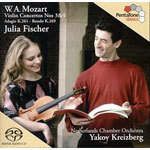
Violin Concertos Nos 3 & 4 / Adagio K.261 / Rondo K.269
 $40.00
Out of Stock
$40.00
Out of Stock6+ weeks add to cart
W.A. MOZART
Violin Concertos Nos 3 & 4 / Adagio K.261 / Rondo K.269
Julia Fischer (violin) / Netherlands Chamber Orchestra / Yakov Kreizberg
[ Pentatone SACD / Hybrid SACD ]
Release Date: Saturday 22 October 2005
This item is currently out of stock. It may take 6 or more weeks to obtain from when you place your order as this is a specialist product.
MARBECKS STAFF RECORDING OF THE YEAR 2006 - "These are crisply aerated and flexible performances. With Kreizberg at the helm of the Netherlands Chamber Orchestra the orchestral sound world is strong on textual clarity and string choir separation"
(MusicWeb Sept 2005)
Hybrid/SACD Playable on all compact disc players
MARBECKS STAFF RECORDING OF THE YEAR 2006
"Every note gives the impression of being there for a reason, articulated through attack, dynamic phrasing, and timbre, but at the same time integrated into the whole. Incredibly mature playing for a 22 year old."
Five Stars (Orchestral choice of the Month) BBC Music Mag (Nov 05)
"Hardly a month goes by without another new release from the young German violinist Julia Fischer - or so it seems. Now here's another, in Pentatone's multichannel hybrid SACD series, that promotes Fischer as a Mozartian after having impressed most sane auditors with her Russian repertoire recently. She plays the two concertos to which I'm most partial, those in G and D and adds the Adagio and the Rondo for violin and orchestra to bring the disc up to a respectable hour in length - though I'd like to have heard something more; has she ever joined with Tabea Zimmerman in the Sinfonia Concertante I wonder?
Let's not get bogged down with what we don't have. These are crisply aerated and flexible performances. With Kreizberg at the helm of the Netherlands Chamber Orchestra the orchestral sound world is strong on textual clarity and string choir separation; a chamber perspective that renounces big boned romanticism in favour of mobility and lighter textures. The winds are especially characterful in the opening of the concerto in G where Fischer displays some of her wide range of subtly deployed tonal colours and also one or two personalised approaches to rhythm. She plays a wide range of cadenzas, another notable feature of her approach; her own in the opening movement of the Concerto in G, Kreizberg's in the slow movement and the Sam Franko in the finale, with small emendations by Fischer. In the Fourth Concerto she plays two of her own cadenzas and employs the Joachim for the finale. The horns seem just a shade over prominent throughout, not least in the slow movement, though this may be a feature of the surround sound perspective, and the slow movement pizzicati sound a touch heavy as well; I'm not so keen on one or two rather mannered lurches from Fischer either. But I enjoyed the echo effects in the finale - these are brought out very attractively, and she rips into her cadential passages with great aplomb.
The Fourth Concerto garners an attractive reading. Clarity fuses with warmth though once more the slow movement sounds a tad emphatically phrased with respect to instrumental pointing and dynamics. The finale is etched with a certain smiling swagger and Fischer ensures that tonal shading is always musically deployed. It's a most enjoyable reading - overwhelmingly unmannered, a touch cool, but sympathetic. The makeweights are equally satisfactory; I was particularly taken by the warm and supportive cushion Kreizberg provides in the Adagio.
Recommendations are difficult because this is a SACD (but playable on CD players)and because of the choice of these two particular concertos. I welcome her playing though it doesn't efface primary recommendations in this repertoire (Grumiaux, Szeryng, et al). But I'd like to hear K364 with Fischer and Zimmerman."
(MusicWeb Sept 2005)
Tracks:
Violin Concerto No.3 in G K216 [23.37]
Violin Concerto No.4 in D K218 [22.28]
Adagio for violin and orchestra in E K261 [7.55]
Rondo for violin and orchestra in B flat K269 [6.23]



